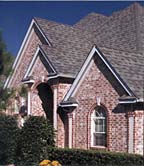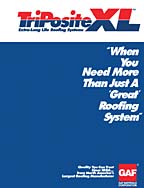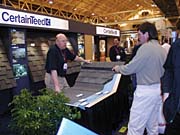

In spite of an uncertain economy, manufacturers of roofing systems continue to roll out new products and systems. Elk has introduced a new shingle product that is nothing short of revolutionary. Firestone and Carlisle both introduced EPDM systems with warranties now reaching 30 years, and GAF has introduced a hybrid low-slope system that can qualify for 32 years. All manufacturers involved in asphalt roofing, led by Owens Corning’s Trumbull Division, sounded the alarm over continuing political and social strife in Venezuela. Mule-Hide and several other manufacturers touted their “no hot stuff” modified bitumen solution — self-adhered MB membranes. Finally, our good friend AG Zalal of North American Bocker told us about a new sheet metal mechanic’s training school that has begun to catch on at his Raleigh, N.C., headquarters.
Here’s our view of some of these new products and schemes. For full details, contact the manufacturers, all of whom are listed in the print and online version of our Buyers Guide, which you can find at www.roofingcontractor.com.

New Shingle Causes Big Flap
The Elk Prestique Grande High Definition shingle debuted in New Orleans. What is so revolutionary? Several points make this steep-slope roofing product an “Editor’s Choice.”
- It offers a totally new profile in a laminated shingle product.
- It is made and installed in a completely innovative way.
- At 48 shingles per square, it ranks in the high range of productivity.
- The nailing area is greatly expanded, making it further “user-friendly.”
- Its size and exposure competes with the “super-lams,” but it is priced in the range of a conventional laminated shingle
The Elk Prestique Grande as the cut and look of a traditional shake-style laminated shingle, except for the fact that it has an 8 1/4-inch exposure instead of the traditional 5- to 6-inch exposure. This is significant for a couple of reasons relating to the look of the shingle in many architectural applications, but the design and installation make this shingle truly unique.
Instead of simply “super-sizing” the shingle, the Prestique Grande's manufactured with the traditional fiberglass-mat, asphalt-ceramic-granule package on the exposed part and a small section of the concealed part of the shingle. Most of the concealed part of the shingle is made of a waterproof, non-asphaltic membrane that is creased and folded back over the top of the shingle. This “flap” has the effect of reducing the overall weight of the shingle and keeping the size of the package in the “normal” range of width and length.
According to videos of the Prestique Grande being installed, it seemed that dealing with the flap made no material difference to the installers. Another feature built into this shingle is a wide nailing area. The concept of a wider nailing area was introduced a few years ago by Malarkey Roofing with the company’s “Zone” concept, which took the nailing pattern from a 1/2-inch strip to a wide target of 1 3/4 inches. It is good to see this feature incorporated into more shingle products.
In short, coming up with a unique looking product that can be installed with less labor and that actually decreases the use of asphalt, strikes us as something more than a novelty. How will the market react to this product? Some of us will have to wait for a while to find out as the initial rollout of the Prestique Grande is limited to Texas, Oklahoma,
Arkansas,Kansas,North Dakota, South Dakota,
Minnesota, Illinois, Missouri, Indiana, Iowa, Nebraska, Louisiana, New
Mexico and Wisconsin.
There are also a relatively limited number of colors available as of this writing. We are betting that with broad acceptance, this product will move into the mainstream in a fairly short period of time.

Low Slope, High Mileage
We noted a couple of new battlegrounds forming on the low-slope front this year. Notable were EPDM producers Firestone and Carlisle both prominently featuring systems with an available 30-year warranty. Last year we witnessed quite a stir on the steep-slope side when manufacturers all increased warranties without significant changes in their products. This seems to be a case, as with the high-end polymer metal roof coatings, where a product has withstood the test of time and has been enhanced and improved to qualify for a longer warranty. Not laboratory time, real time.Also, seeking to differentiate themselves from the emerging TPO and PVC products that tout their bright reflective surfaces, EPDM producers have sought to point to their many years of proven performance on the job. In addition to this, producers have banded together to form the EPDM Roofing Association to promote EPDM and to tell the “whole story” of energy-efficient roofing. Their claim is that reflectivity is only part of the picture, and that roof insulation makes, in many cases, an even more significant impact on system’s energy performance. Either way you view it, the argument about dark vs. white roofing needs to be played out. EPDM performance claims can now be backed up with many, many squares of success.
Carlisle also prominently featured its “hot-mopped” EPDM system with factory-applied seam tape. This system is intriguing if only because of the unique blending of disciplines: “Fleeceback” EPDM roofing, hot asphalt application, and a pressure-sensitive lap. Carlisle also showed us some new equipment and installation methods that are sure to make this system more attractive to roofing contractors and owners alike.
Another multi-discipline low-slope system comes from GAF. The company’s TriPosite XL – Extra Long Life Roofing Systems consists of a base layer of iso roof insulation over which a venting base sheet is installed followed by layers of hot-mopped, high-strength Type VI felts or SBS-modified bitumen membrane. All of this is topped by GAF’s EverGuard fleeceback TPO or PVC membrane. Tailoring this system to the desires of the building owner, GAF allows for an extension of the warranty up to a total of 32 years when the system is installed and maintained by a roofing contractor qualified as a GAF “Master Select” contractor.
What’s the big deal about bigger, better, more expensive low-slope roofing systems? To begin with, building owners have consistently told us in casual conversation and in surveys: “We want top-performing systems … we don’t want roofing problems.” Single-ply manufacturers went through some years racing to see who could get to the bottom price first. It is refreshing to now see a competition to find out who can come up with the best thermal and waterproofing system.

Asphalt Woes
There is trouble stemming from the general strike and petroleum industry strike in Venezuela. There is not much we can add to this except to point out how significant an issue it was around the convention floor this year. We spoke to a number of asphalt suppliers, all of whom could only speculate as to what this year will bring.Key points that are worth remembering: As of the mid-February NRCA convention time, the paving season had not begun. As a user of asphalt, the paving industry dwarfs the roofing industry. Producers are all used to the ebb and flow of the seasons, but none can predict how long the political and social unrest in Venezuela will affect the price and availability of asphalt.
As of this writing, numerous price increases have hit the prepared asphalt roofing market, and there is a surge of fuel and transportation related surcharges being floated into the market. As we have been saying for some time: Keep a short leash on prices and include escalators whenever and wherever you can. You just do not know today what you will be facing when sourcing jobs six months, or even six weeks from now.
Self-adhered Modified Bitumen (SAMB)
Just what we need in this business, another acronym! But there does seem to be a growing demand for SAMB roofing. There were a number of different products shown in New Orleans, but the system touted by the folks at Mule-Hide Products Co. Inc. caught our eye.The Mule-Hide SAMB systems boast a “dual compound” technology. This product line comes in both APP and SBS on the top surface above the reinforcement with a specially formulated pressure-sensitive adhesive beneath the reinforcement. According to Mule-Hide, this new-generation adhesive system offers 10 times greater adhesion than “single compound” products.
SAMB systems of all stripes are gaining notoriety among roofing contractors due to the fact that they do not require a torch or hot asphalt to apply. The Mule-Hide SAMBs have been formulated to install over eight different substrates. With a choice of ceramic granule colors, or smooth surface suitable for coating, the finished product is smooth, attractive and clean.
Small Investment in Time, Big Return in Knowledge
We made a surprise discovery while visiting our good friend, AG Zalal, at the North American Bocker booth. Zalal had his usual array of portable telescoping hoists and accessories. He also had the usual group of hand tools for sheet metal work and even a live demonstration featuring zinc roofing being installed. It was when we overheard Zalal speaking with a contractor about his sheet metal school that our interest was piqued.
Zalal came into the roofing business quite by accident. He studied at the Afghanistan Institute of Technology, an American-styled technical school in his native Afghanistan, and then taught there for nine years. Zalal then made his way to the United States to learn more at a similar institution in Milwaukee where he studied sheet metal. In 1964, he found himself studying again at Indiana State University, after which he went back home, only to return as a “special student” for more studies at North Carolina State University. Following his studies there, Zalal was seeking work when he walked into a roofing company by mistake (looking for another place). Following an interview at Caton & Wright Roofing in 1969, Zalal began his career in roofing. By 1970 he had started his own roofing business, and by the early 1990s, he began to devote full time to his burgeoning business selling the North American Bocker hoist and sheet metal tools.
For many years, given all his technical education and experience as a roofing contractor, Zalal has enjoyed a reputation as a resource for technical information about sheet metal tools and techniques. For the first time in 33 years, he stared holding school for sheet metal mechanics at his Raleigh, N.C., shop.
Zalal, in conjunction with VM Zinc, is hosting three-day courses in the installation of zinc roofing and cladding. According to Zalal, “Once you learn to handle zinc, handling copper, stainless, steel, or aluminum — no problem.” Comparatively, zinc is very hard to work with because it is very sensitive to temperature and fractures fairly easily. Expansion and contraction is a huge factor in the installation of zinc. Zalal expects to hold three or four of the three-day courses this year. So far, roofing contractors, sheet metal mechanics and architects have taken advantage of the course.
To Zalal, only “the perfect” roofing system will do. To that end, he continues to work out details of marketing the Sharkskin stainless steel roofing system. Zalal is convinced that this fully sealed system is the best roof known to man. The Sharkskin system is welded and requires special equipment and training, all of which are available in Raleigh.

Report Abusive Comment